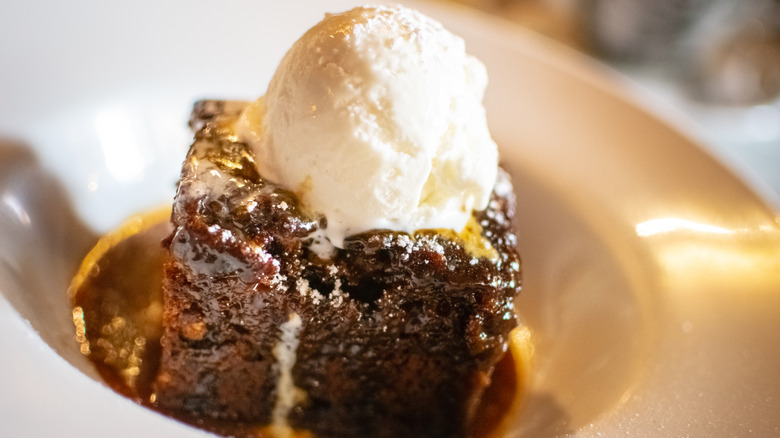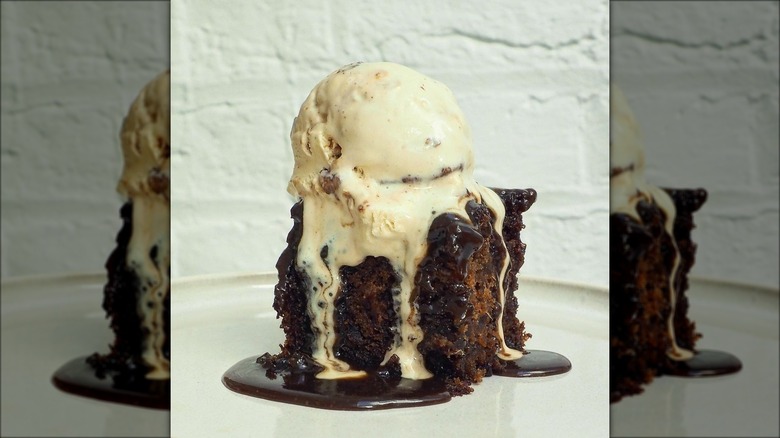The Origin Of Sticky Toffee Pudding Is More Dramatic Than You Think
Food historians attempting to trace the origins of sticky toffee pudding have their work cut out for them. The dessert so often associated with Great Britain may not be British at all. And despite assumptions to the contrary, it probably wasn't on Victorian Christmas menus. To be fair, 18th-century holiday feasts in Britain probably featured a cake-like pudding, but it was more likely the aptly named Christmas pudding. Similar but different, the precursor to sticky toffee pudding is a spiced molasses steamed confection made with suet and soaked in brandy.
According to BBC, British author Tess Baxter set the timeline straight in 2012. In her book "The Lake District and Cumbria in Recipes and Photographs," Baxter asserts, "Sticky toffee pudding is such a favorite today that it seems that it must always have been around. However, it is a relatively recent addition to the local recipe book." Baxter claims Sharrow Bay Hotel in the Cumbria region of Great Britain introduced the confection in the 1970s.
This is where it gets, well, sticky. While it's true that Cumbria is known for mouth-watering confections like Cumberland rum nicky (lattice-topped crystallized ginger and fruit tart) and Borrowdale tea bread (fruit-studded cake soaked in tea), the region's connection to sticky toffee pudding is a bit more tenuous. As Sarah Holliday, co-owner of the Cartmel Village Shop, a longtime Cumbrian purveyor of sticky toffee pudding, told BBC, "We've championed it, embraced it and pushed it forward more than anyone else. But we did not invent it."
The twisty story of sticky toffee pudding
By and large, sticky toffee pudding connoisseurs acknowledge its connection to Cumbria. Since introducing the sweet confection to its product list in 1984, the Cartmel Village Shop has sold more than 10 million puddings. However, the exact location of its genesis remains a mystery. To further complicate matters, there's also a rumored link to an origin story that begins in Canada. And in a twist worthy of an Agatha Christie novel, both stories converge at the aforementioned Sharrow Bay Hotel. And both involve 20th-century British chef (and co-owner of the Sharrow Bay Hotel) Francis Coulson. But contrary to Tess Baxter's assertion that sticky toffee pudding was introduced by the Cumbrian hotel in the 1970s, other accounts pin the sweet dessert's debut to the 1940s.
By some accounts, Royal Canadian Air Force pilots' use of maple syrup during World War II inspired Coulson's business partner, Brian Sack, to develop the dessert. Another theory bypasses Sack completely but maintains the Canadian connection. As the story goes, members of the Royal Canadian Air Force serving in Britain during World War II shared the recipe with Patricia Martin, a Lancashire hotelier who gave it to Francis Coulson years later. Rumor has it that Coulson confirmed the recipe's Lancashire connection sometime before his death in 1998, acknowledging that he received it from Martin but made a few changes before adding it to the Sharrow Bay House menu. And we haven't even touched lesser-known rumors like the story that pins the debut of sticky toffee pudding to 1907. Sticky business, indeed.

